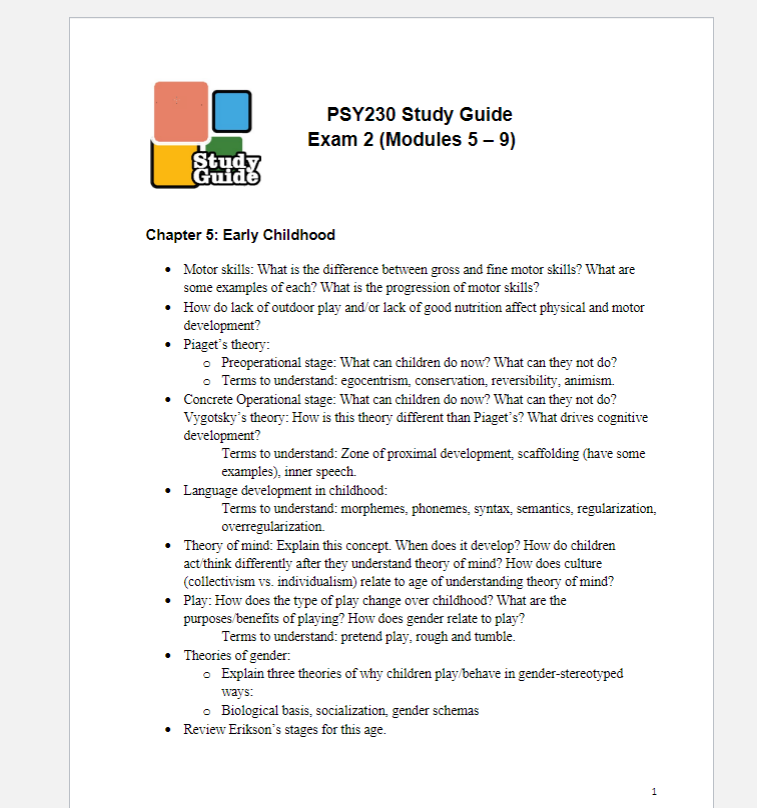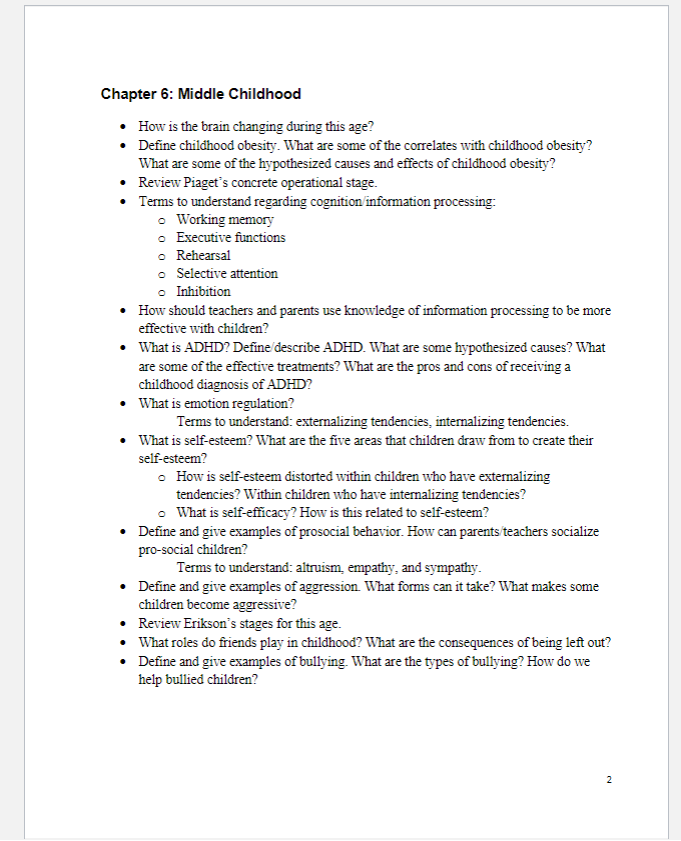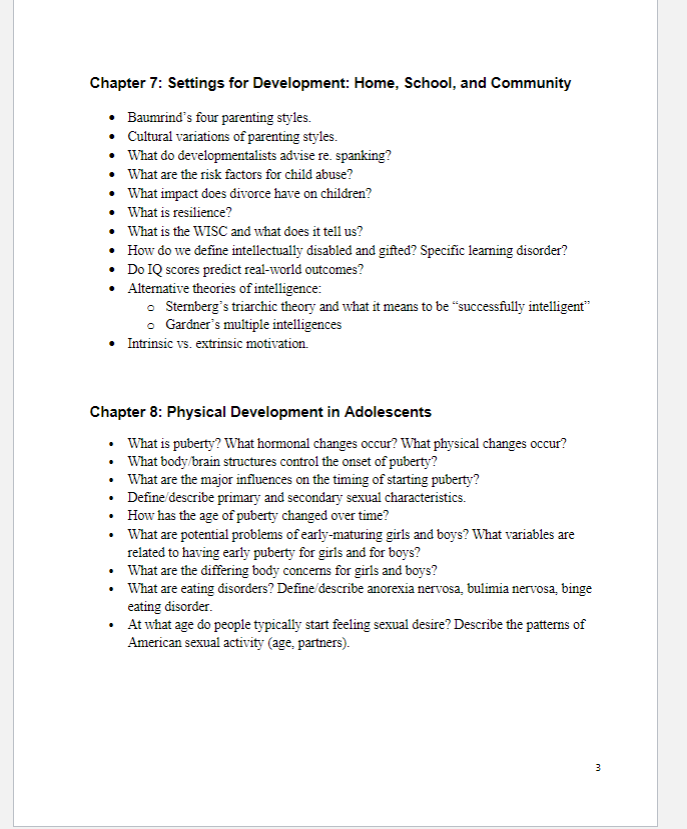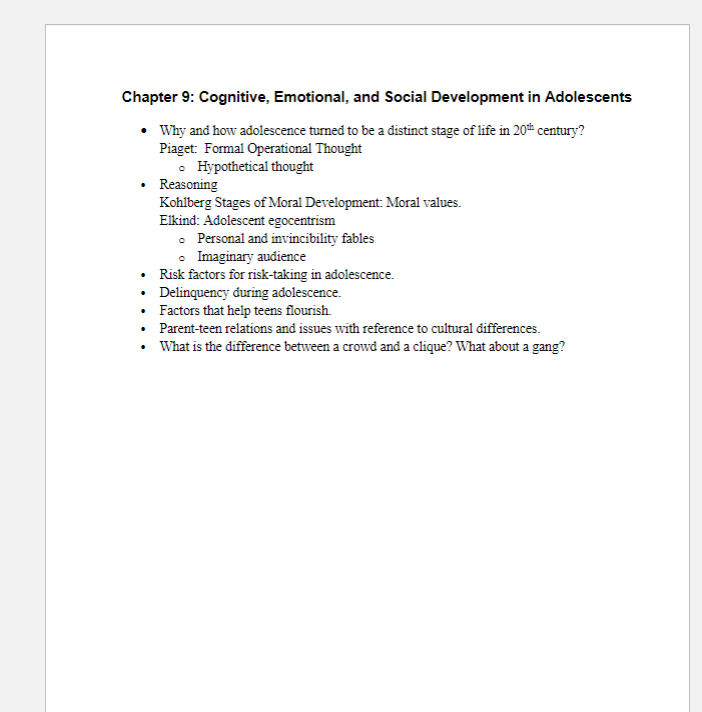Answered step by step
Verified Expert Solution
Question
1 Approved Answer
Study Guide PSY230 Study Guide Exam 2 (Modules 5 - 9) Chapter 5: Early Childhood Motor skills: What is the difference between gross and




Study Guide PSY230 Study Guide Exam 2 (Modules 5 - 9) Chapter 5: Early Childhood Motor skills: What is the difference between gross and fine motor skills? What are some examples of each? What is the progression of motor skills? How do lack of outdoor play and/or lack of good nutrition affect physical and motor development? Piaget's theory: o Preoperational stage: What can children do now? What can they not do? o Terms to understand: egocentrism, conservation, reversibility, animism. Concrete Operational stage: What can children do now? What can they not do? Vygotsky's theory: How is this theory different than Piaget's? What drives cognitive development? Terms to understand: Zone of proximal development, scaffolding (have some examples), inner speech. Language development in childhood: Terms to understand: morphemes, phonemes, syntax, semantics, regularization, overregularization. Theory of mind: Explain this concept. When does it develop? How do children act/think differently after they understand theory of mind? How does culture (collectivism vs. individualism) relate to age of understanding theory of mind? Play: How does the type of play change over childhood? What are the purposes/benefits of playing? How does gender relate to play? Terms to understand: pretend play, rough and tumble. Theories of gender: o Explain three theories of why children play/behave in gender-stereotyped ways: o Biological basis, socialization, gender schemas Review Erikson's stages for this age. Chapter 6: Middle Childhood How is the brain changing during this age? Define childhood obesity. What are some of the correlates with childhood obesity? What are some of the hypothesized causes and effects of childhood obesity? Review Piaget's concrete operational stage. Terms to understand regarding cognition/information processing: o Working memory o Executive functions o Rehearsal o Selective attention o Inhibition How should teachers and parents use knowledge of information processing to be more effective with children? What is ADHD? Define/describe ADHD. What are some hypothesized causes? What are some of the effective treatments? What are the pros and cons of receiving a childhood diagnosis of ADHD? What is emotion regulation? Terms to understand: externalizing tendencies, internalizing tendencies. What is self-esteem? What are the five areas that children draw from to create their self-esteem? o How is self-esteem distorted within children who have externalizing tendencies? Within children who have internalizing tendencies? o What is self-efficacy? How is this related to self-esteem? Define and give examples of prosocial behavior. How can parents teachers socialize pro-social children? Terms to understand: altruism, empathy, and sympathy. Define and give examples of aggression. What forms can it take? What makes some children become aggressive? Review Erikson's stages for this age. What roles do friends play in childhood? What are the consequences of being left out? Define and give examples of bullying. What are the types of bullying? How do we help bullied children? 2 Chapter 7: Settings for Development: Home, School, and Community Baumrind's four parenting styles. Cultural variations of parenting styles. What do developmentalists advise re. spanking? What are the risk factors for child abuse? What impact does divorce have on children? What is resilience? What is the WISC and what does it tell us? How do we define intellectually disabled and gifted? Specific learning disorder? Do IQ scores predict real-world outcomes? Alternative theories of intelligence: Sternberg's triarchic theory and what it means to be "successfully intelligent" Gardner's multiple intelligences Intrinsic vs. extrinsic motivation. Chapter 8: Physical Development in Adolescents What is puberty? What hormonal changes occur? What physical changes occur? What body/brain structures control the onset of puberty? What are the major influences on the timing of starting puberty? Define/describe primary and secondary sexual characteristics. How has the age of puberty changed over time? . What are potential problems of early-maturing girls and boys? What variables are related to having early puberty for girls and for boys? What are the differing body concerns for girls and boys? What are eating disorders? Define/describe anorexia nervosa, bulimia nervosa, binge eating disorder. At what age do people typically start feeling sexual desire? Describe the patterns of American sexual activity (age, partners). 3 Chapter 9: Cognitive, Emotional, and Social Development in Adolescents Why and how adolescence turned to be a distinct stage of life in 20th century? Piaget: Formal Operational Thought Hypothetical thought Reasoning Kohlberg Stages of Moral Development: Moral values. Elkind: Adolescent egocentrism Personal and invincibility fables Imaginary audience Risk factors for risk-taking in adolescence. Delinquency during adolescence. Factors that help teens flourish. Parent-teen relations and issues with reference to cultural differences. What is the difference between a crowd and a clique? What about a gang? . .
Step by Step Solution
There are 3 Steps involved in it
Step: 1
Motor Skills Gross motor skills involve the use of large muscles and coordination of the whole body such as running or jumping Fine motor skills involve the use of small muscles particularly in the ha...
Get Instant Access to Expert-Tailored Solutions
See step-by-step solutions with expert insights and AI powered tools for academic success
Step: 2

Step: 3

Ace Your Homework with AI
Get the answers you need in no time with our AI-driven, step-by-step assistance
Get Started


